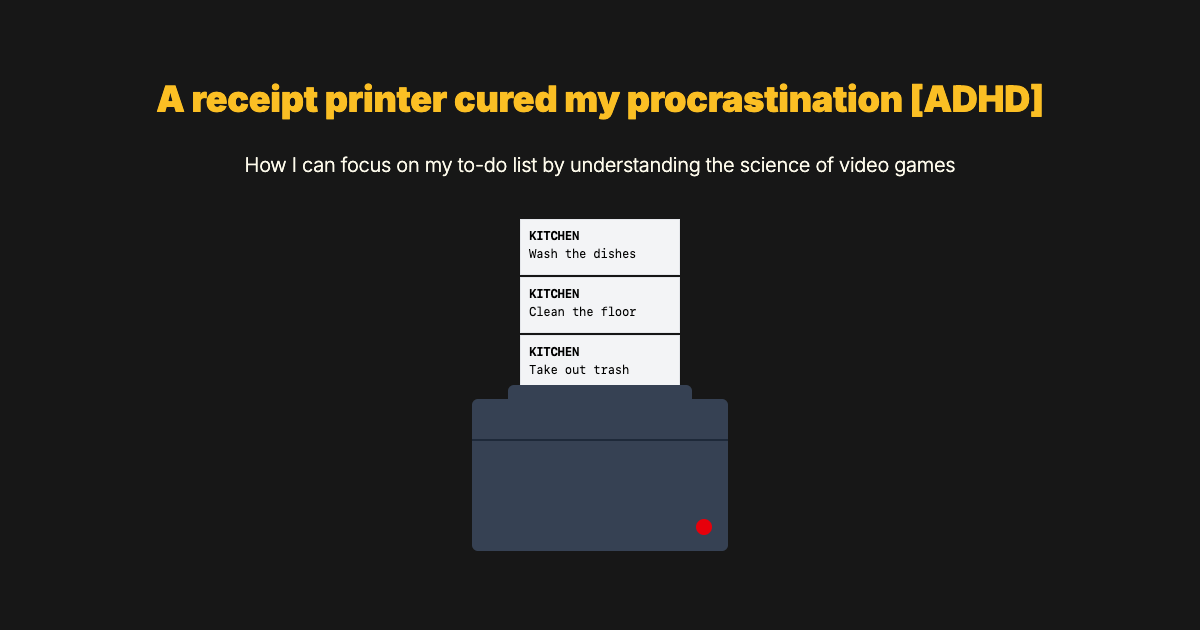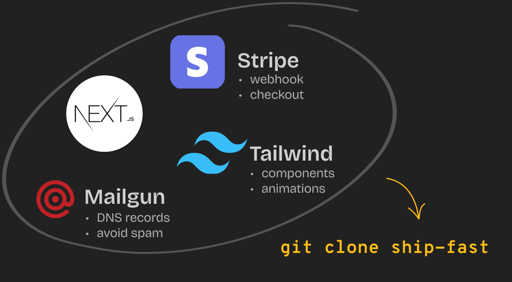A receipt printer cured my procrastination [ADHD]
-
This post did not contain any content.

A receipt printer cured my procrastination [ADHD]
Why can I focus for hours on a game but procrastinate on simple tasks? I finally cracked the code using thermal receipt printer and game design.
(www.laurieherault.com)
Oooh cool! I'll be watching for the release of this software with great interest!
-
This post did not contain any content.

A receipt printer cured my procrastination [ADHD]
Why can I focus for hours on a game but procrastinate on simple tasks? I finally cracked the code using thermal receipt printer and game design.
(www.laurieherault.com)
Games are easy to start, even with low motivation.
I feel like I spend more time keeping the thing in working order, filling up forms, entering 2fa codes, clicking on verification emails, realizing the driver has updated, so the workflows that has been working before are now broken, but some that were broken are working again... and by that point I don't even want to play.
-
This post did not contain any content.

A receipt printer cured my procrastination [ADHD]
Why can I focus for hours on a game but procrastinate on simple tasks? I finally cracked the code using thermal receipt printer and game design.
(www.laurieherault.com)
For anyone needing something like that right now - not wanting to wait for their release I can recommend Tody. It really helped me and my SO.
-
This post did not contain any content.

A receipt printer cured my procrastination [ADHD]
Why can I focus for hours on a game but procrastinate on simple tasks? I finally cracked the code using thermal receipt printer and game design.
(www.laurieherault.com)
For my case, I already cut up my tasks finely. I just need LogSeq to add a confetti animation once I mark a task as Done.
-
This post did not contain any content.

A receipt printer cured my procrastination [ADHD]
Why can I focus for hours on a game but procrastinate on simple tasks? I finally cracked the code using thermal receipt printer and game design.
(www.laurieherault.com)
I kind of do want a receipt printer to play with now but I don't think I want to adopt the whole software system. This seems very cleaning focused. Cleaning actually is my procrastination. I clean to tell myself I'm too busy cleaning to deal with more complex issues.
-
This post did not contain any content.

A receipt printer cured my procrastination [ADHD]
Why can I focus for hours on a game but procrastinate on simple tasks? I finally cracked the code using thermal receipt printer and game design.
(www.laurieherault.com)
Kinda reminds me of the Little Printer from Berg, which came out ocer a decade ago. https://www.fastcompany.com/90352461/the-little-printer-a-cult-classic-of-2010s-design-is-back
-
I kind of do want a receipt printer to play with now but I don't think I want to adopt the whole software system. This seems very cleaning focused. Cleaning actually is my procrastination. I clean to tell myself I'm too busy cleaning to deal with more complex issues.
i cant clean when i need to, but when i have other pressing tasks, suddenly I'm cleaning. not doing what I'm supposed to be doing, but I'm still "productive" is what i tell myself... not that it works at keeping away the guilt very well.
-
I'll read this article later
Hey! Watch it pal!
Friendly fire seems to be active, because I feel very much attacked by your comment xD
I will just save this post so I can read it later when I have time. -
i cant clean when i need to, but when i have other pressing tasks, suddenly I'm cleaning. not doing what I'm supposed to be doing, but I'm still "productive" is what i tell myself... not that it works at keeping away the guilt very well.
WHY ARE WE LIKE THIS
-
This post did not contain any content.

A receipt printer cured my procrastination [ADHD]
Why can I focus for hours on a game but procrastinate on simple tasks? I finally cracked the code using thermal receipt printer and game design.
(www.laurieherault.com)
There's already an app for this, called Goblin Tools. It breaks down tasks for you into more easily digestible subtasks.
-
This post did not contain any content.

A receipt printer cured my procrastination [ADHD]
Why can I focus for hours on a game but procrastinate on simple tasks? I finally cracked the code using thermal receipt printer and game design.
(www.laurieherault.com)
Make sure to use the phenol-free paper.
-
This post did not contain any content.

A receipt printer cured my procrastination [ADHD]
Why can I focus for hours on a game but procrastinate on simple tasks? I finally cracked the code using thermal receipt printer and game design.
(www.laurieherault.com)
Did I just read an ad for his app?
-
Did I just read an ad for his app?
I plan to release my software publicly in the coming weeks. You can subscribe to my newsletter to get notified when it's available.
Yup.
-
This post did not contain any content.

A receipt printer cured my procrastination [ADHD]
Why can I focus for hours on a game but procrastinate on simple tasks? I finally cracked the code using thermal receipt printer and game design.
(www.laurieherault.com)
Health a Safety Risk: https://www.theguardian.com/us-news/2025/apr/14/paper-receipt-chemical-bisphenol-s
Please don't do this. Stores need to stop with the plastic infused receipt paper that leaches into your skin in seconds.
If the author used anything but Twitter or LinkedIn, I'd be inclined to inform them,, but oh well.
-
There's already an app for this, called Goblin Tools. It breaks down tasks for you into more easily digestible subtasks.
Is there a self hosted version of it/something like it?
-
Is there a self hosted version of it/something like it?
Not that I'm aware of.
-
Health a Safety Risk: https://www.theguardian.com/us-news/2025/apr/14/paper-receipt-chemical-bisphenol-s
Please don't do this. Stores need to stop with the plastic infused receipt paper that leaches into your skin in seconds.
If the author used anything but Twitter or LinkedIn, I'd be inclined to inform them,, but oh well.
Good to know. Also an easy problem to fix. Just use phenol free paper.
-
-
Bluesky finally got Activity Notifications, you can now follow news and accounts with it.
Technology 2
2
-
$440 Charge For A Wheel Scuff Raises Questions About Hertz's AI Rental Car Damage Scanner
Technology 1
1
-
-
Never run out of content again. Mojo Video generates unlimited original videos with a single click.
Technology 1
1
-
-
 2
2
-



